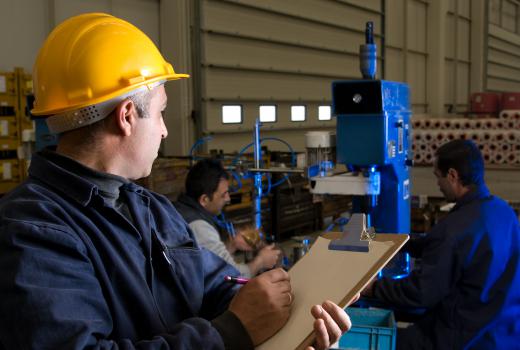Workflow in general is a method of designing and organizing a process designed to perform a function in the most efficient way possible. In manufacturing, this refers to devising an objective process designed to help meet the goals of a manufacturing order. Goals when manufacturing a product for a customer can include product creation, meeting product specifications, and completing the manufacturing and product delivery on time. The best manufacturing workflow will take information about the company and product into account, producing a custom manufacturing workflow program made especially for your specific company and product.
Manufacturing workflow designs used by similar manufacturing organizations for similar products may be able to guide you in designing the best workflow for your company. Be sure that you choose a workflow model that is similar to your company's situation. Trying to use the manufacturing workflow designed by another company or for another type of product without adapting the plan for your own company will leave many options for error in the workflow sequence. Know the abilities and limits of participants of the manufacturing process, and tailor your plan to keep workers efficient and alert so they can product a quality product.

Another vital part of a manufacturing workflow is managing the materials needed for the manufacturing process. A workflow manager needs to design the workflow so manufacturing happens when materials are available in the amounts necessary to perform the manufacturing process. Manufacturing workflow also needs to take into account how much time each part of the workflow process takes to help company management make a reasonably accurate estimate of the date or time of product delivery.
Quality control within the manufacturing process can help ensure that the product meets the specifications set by the customer. A customer can be an individual or another company ordering multiple product units. Often, product specifications are contained in a legal contract for the sale, so it is important to ensure that the product meets the specifications before it leaves the manufacturing facility, or you have not legally fulfilled the order. Quality control should be included in all parts of the manufacturing process, not just at the end. If a product consists of multiple parts, each part must be checked for compliance to specifications before it moves on to the assembly stage.
Make room for adjustments to the workflow plan if needed. During the process of manufacturing a product, you may run into obstacles that interrupt planned production. Anticipating problems and preparing solutions for likely problems can help reduce the chance of encountering a problem. Part of an effective manufacturing workflow includes wiggle room in anticipation of setbacks and problems. Even if the workflow seems flawless, be aware that unexpected problems can occur, even in the most meticulously designed of manufacturing workflow plans.
